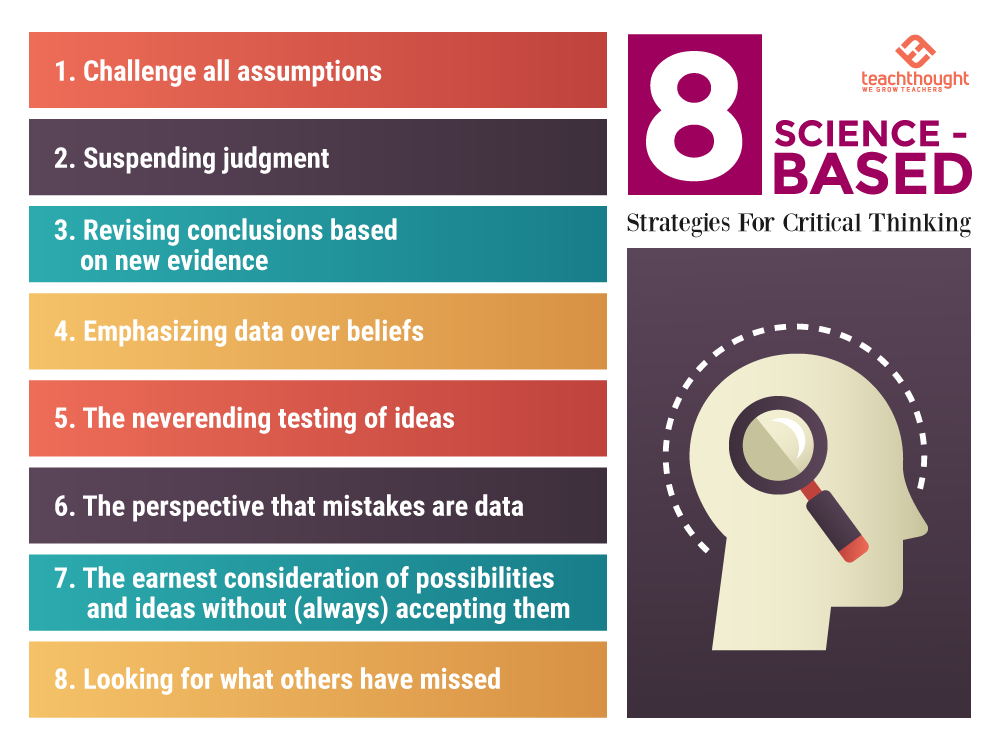
What Are The Best Science-Based Strategies For Critical Thinking?
contributed by Lee Carroll, PhD and Terry Heick
Scientific argumentation and critical thought are difficult to argue against.
However, as qualities and mindsets, they are often the hardest to teach to students. Einstein himself said, “Education is not the learning of facts, but the training of the mind to think.”
But how? What can science and critical thinking do for students? And further, what can teachers learn from these approaches and take to their classrooms?
Outside of science, people are quick to label those who question currently accepted theories as contrarians, trolls, and quacks. This is, in part, because people are sometimes not aware of how science moves forward.
Interestingly, professional teaching journals point out that a common myth students bring to school is that science is already all discovered and carved in stone–a fixed collection of knowledge–rather than the simple approach to thinking and knowledge it actually represents.
Below are 8 science-based strategies for critical thinking.
8 Science-Based Strategies For Critical Thinking
1. Challenge all assumptions
And that means all assumptions.
As a teacher, I’ve done my best to nurture the students’ explorative questions by modeling the objective scientific mindset. Regardless of our goals in the teaching and learning process, I never want to squelch the curiosity of students. One way I accomplish this is by almost always refraining from giving them my personal opinion when they’ve asked, encouraging them instead to tackle the research in order to develop their own ideas.
Students are not used to this approach and might rather be told what to think. But wouldn’t that be a disservice to their development, knowing we need analytical minds to create progress? And knowing how fast technology converts science fiction into fact? Concepts that were pure imagination when I grew up, like time travel, have now been simulated with photons in Australia. Could this happen if we never challenged our assumptions?
Question everything. In that regards, questions are more important than answers.
2. Suspending judgment
If a student shows curiosity in a subject, it may challenge our own comfort zone. Along these lines, Malcolm Forbes—balloonist, yachtsman, and publisher of Forbes magazine—famously declared, “Education’s purpose is to replace an empty mind with an open one.”
Although it’s human nature to fill a void with assumptions, it would halt the progress of science and thus is something to guard against. Admittedly, it requires bravery to suspend judgment and fearlessly acquire unbiased data. But who knows, that data may cause us to look at things in a new light.
3. Revising conclusions based on new evidence
In adopting student-centered learning, the Next Generation Science Standards feature scientific argumentation. Can we agree that change based on new evidence may be useful in creating a healthier world?
Resisting confirmation bias, scientists are required to revise conclusions–and thus beliefs–in the presence of new data.
4. Emphasizing data over beliefs
In science, ‘beliefs’ matter less than facts, data, and what can be supported and proven. The development of beliefs based on critical reasoning and quality data is much closer to a science-based approach to critical thinking.
While scientists certainly do ‘argue’ amongst themselves, helping students frame that disagreement as being between data rather than people is a very simple way to teach critical thinking through science. Seeing people and beliefs and data as separate is not only rational, but central to this process.
5. The neverending testing of ideas
At worst, new tests are designed to again test those new conclusions. Theories are wonderful starting points for a process that never stops!
6. The perspective that mistakes are data
Viewing mistakes as data and data as leading to new conclusions and progress is part and parcel to the scientific process.
Just so, one of the fallouts of teaching critical thinking skills is that students may bring home misunderstandings. But exploring controversy in science is the very method that scientists use to propel the field forward.
Otherwise, we would still be riding horses and using typewriters. Did you know that it was once considered controversial to put erasers on pencils? People thought it would encourage students to make mistakes.
7. The earnest consideration of possibilities and ideas without (always) accepting them
However valuable it has proven to explore controversy in science, some students may not be able to wrap their heads around (one of) Aristotle’s famous quote about education: “It is the mark of an educated mind to be able to entertain a thought without accepting it.”
Without teachers and parents together supporting students through this, children may lose the context of why they should challenge their own assumptions via evidence and analytical reasoning inside and outside of the classroom.
8. Looking for what others have missed
Looking over old studies and data–whether to draw new conclusions or design new theories and tests for those theories–is how a lot of ‘science’ happens. Even thinking of a new way to consider or frame an old problem–to consider what others may have missed–is a wonderful critical thinking approach to learning.